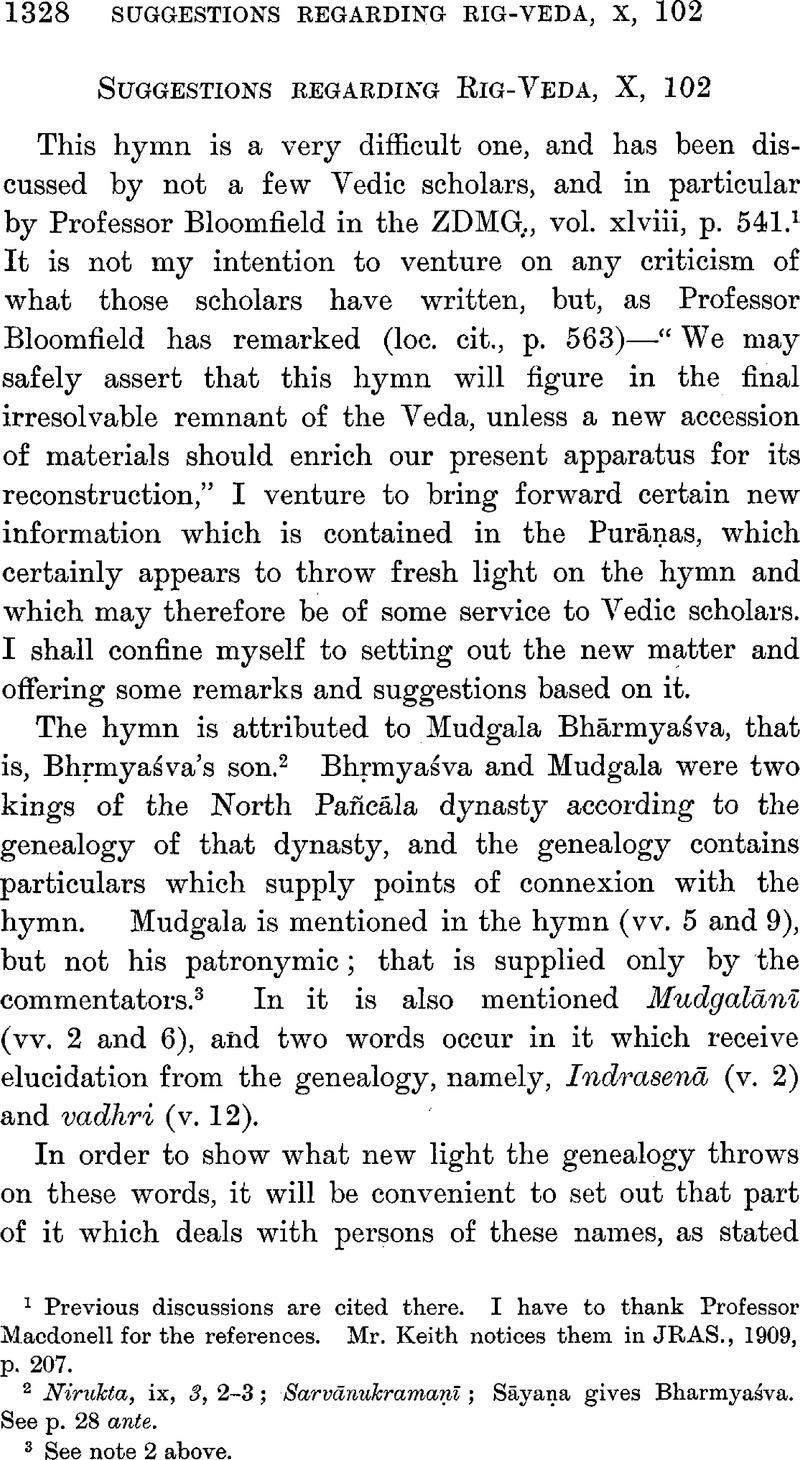Article contents
Suggestions regarding Rig-Veda, X, 102
Published online by Cambridge University Press: 15 March 2011
Abstract

- Type
- Miscellaneous Communications
- Information
- Copyright
- Copyright © The Royal Asiatic Society 1910
References
page 1328 note 1 Previous discussions are cited there. I have to thank Professor Macdonell for the references. MrKeith, notices them in JRAS., 1909, p. 207Google Scholar.
page 1328 note 2 Nirukta, ix, 3, 2–3; Sarvānukramaṇī; Sāyaṇa gives Bharmyaśva. See p. 28 ante.
page 1328 note 3 See note 2 above.
page 1329 note 1 Agni, 277, 19–22; Bhāgavata, ix, 21, 31–4, and 22, 3; Brahma, 13, 93–7; Garuḍa, i, 140, 17–20; Matsya, 50, 1–7; Vāyu (Calc. ed.), ii, 37, 189–96; (Ānandāśr. ed.), 99, 196–200; Viṣṇu, iv, 19, 15–16; and Harivaṁśa, 32, 1777–84.
page 1329 note 2 All confuse this name. The Bhāgav. reads Bharmyāśva and shortly Bharmya; Matsya, Bhadrāśva; Brahma, Bāhyāśva; Agni and Hariv., VāhyāŚva; and Garuḍa and Viṣṇu, Haryaśva. The Vāyu omits. The correct form is certainly Bhṛmyaśva.
page 1329 noet 3 So all, except the Agni and Garuḍa, which read Mukula.
page 1329 note 4 So all, except that the Bhāgav. reads Sañjaya and Matsya Jaya.
page 1329 note 5 So all, except the Garuḍa, which reads Vṛhadbhānu.
page 1329 note 6 So all, except that the Matsya reads Javīnara; Vāyu, Yavīyat; and Viṣṇu, Pravīra.
page 1329 note 7 So the Bhāgav., Vāyu (Ānand. ed.), and Viṣṇu; but the Vāyu (Calc. ed.) reads Kampilya; Garuḍa, Kampilla; Matsya, Kapila; Agni, Kṛmila; and Brahma and Hariv., Kṛmilāśva.
page 1329 note 8 So the Matsya and Vāyu. The Brahma and Hariv. read the patronymic Maudgalya, and the latter gives to Maudgalya a son Brahmarṣi who married Indrasenā. The Agni, Bhāgav., and Garuḍa omit.
page 1329 note 9 So the Brahma, Vāyu, and Hariv. The Matsya gives to Brahmiṣṭha a son named Indrasena instead, who was father of Vadhryaśva. The others omit.
page 1329 note 10 All confuse this name. The Hariv. reads Vadhrasva; Brahma, Vadhrya; Vāyu, Badhyaśva; Viṣṇu, Vṛddhaśva; Matsya, Vindhyāśva; and Agni, Cañcāśva. The others omit. The correct form is clearly Vadhryaśva.
page 1329 note 11 So the Matsya, Vāyu, and Hariv. The others omit.
page 1329 note 12 So all, except the Brahma, which omits.
page 1330 note 1 Agni, 277, 21—
Mukulasya tu Maukulyāḥ kṣetropetā dvijātayaḥ,
where read Mudgalasya, Maudgalyāḥ, and kṣatropetā.
Bhāgav., ix, 21, 33—
Mudgalād brahma-nirvṛttam gotram Maudgalya-sañjñitam.
Matsya, 50, 5–6—
Mudgalasyâpi Maudgalyāḥ kṣatropetá dvijātayaḥ
Ete hy Aṅgirasaḥ pakṣaṁ saṁśritāḥ Kāṇva-Mudgalāḥ
Mudgalasya suto jajñe Brahmiṣṭhaḥ su-mahā-yaśāḥ
Indrasenah sutas tasya Vindhyāśvas tasya câtmajah.
Vāyu (Calc. ed.), ii, 37, 193–5; (Ānandāśr. ed.), 99, 198–200—
Mudgalasyâpi Maudgalyāḥ kṣa(a)tropeta-dvijātayaḥ
Ete hy Angirasaḥ pakṣe saṁśritáḥ Kaṇṭh(v)a-Mudgalāḥ
Mudgalasya suto jyeṣṭho Brahmiṣṭhaḥ su-mahā-yaśāḥ
Indrasenā yato garbham Badhyaśvam pratyapadyata.
Viṣṇu, iv, 19, 16, in prose—
Mudgalāc ea Maudgalyāḥ kṣatropetā dvijātayo babhūvuḥ.
Hariv., 32, 1781–3—
Mudgalasya tu dāyādo Maudgalyaḥ su-mahā-yaśāḥ
Sarva ete mahâtmānaḥ kṣatropetā dvijātayaḥ
Ete hy Aṅgirasaḥ pakṣaṁ saṁśritāḥ Kāṇva-Mudgalāḥ
Maudgalyasya suto jyeṣṭho Brahmarṣiḥ su-mahā-yaśāḥ
Indrasenā yato garbhaṁ Vadhrasvam pratyapadyata.
To which may be added here the Brahma, 13, 97—
Mudgalasya tu dāyādo Maudgalyaḥ su-mahā-yaśāḥ
Indrasenā yato garbhaṁ Vadhryaṁ ca pratyapadyata.
For Vadhryaṁ ca one MS. reads Vadhvaśram.
page 1332 note 1 There was another Mudgala, a son (or descendant) of Viśvāmitra, , M Bh., xiii, 4, 250Google Scholar; Brahma, 10, 59; Hariv., 27, 1462 (Maudgalya, in 32, 1769)Google Scholar; unless his name is an echo of the confusion which derived the Kānyakubja dynasty from Ajamīḍha; see p. 22 ante.
1332 note 2 It does not necessarily follow that the vehicle was a cart because a bull was yoked to it. Chariots were sometimes drawn by other animals, as was Ghaṭotkaca's chariot, which was drawn neither by horses nor by elephants, but by elephant-like beasts, probably huge buffaloes (M Bh., vii, 156, 6785–7). If Mudgala's horses had been carried off, he would naturally have yoked a powerful bull.
- 1
- Cited by


